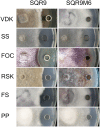Responses of beneficial Bacillus amyloliquefaciens SQR9 to different soilborne fungal pathogens through the alteration of antifungal compounds production
- PMID: 25484880
- PMCID: PMC4240174
- DOI: 10.3389/fmicb.2014.00636
Responses of beneficial Bacillus amyloliquefaciens SQR9 to different soilborne fungal pathogens through the alteration of antifungal compounds production
Abstract
Bacillus amyloliquefaciens SQR9 exhibited predominantly antagonistic activities against a broad range of soilborne pathogens. The fungi-induced SQR9 extracts possess stronger antifungal activities compared with SQR9 monoculture extracts. To investigate how SQR9 fine-tunes lipopeptides (LPs) and a siderophore bacillibactin production to control different fungal pathogens, LPs and bacillibactin production and transcription of the respective encoding genes in SQR9 were measured and compared with six different soilborne fungal pathogens. SQR9 altered its spectrum of antifungal compounds production responding to different fungal pathogen. Bacillomycin D was the major LP produced when SQR9 was confronted with Fusarium oxysporum. Fengycin contributed to the antagonistic activity against Verticillium dahliae kleb, Fusarium oxysporum, Fusarium solani, and Phytophthora parasitica. Surfactin participated in the antagonistic process against Sclerotinia sclerotiorum, Rhizoctonia solani, and Fusarium solani. Bacillibactin was up-regulated when SQR9 was confronted with all tested fungi. The reduction in antagonistic activities of three LP and bacillibactin deficient mutants of SQR9 when confronted with the six soilborne fungal pathogens provided further evidence of the contribution of LPs and bacillibactin in controlling fungal pathogens. These results provide a new understanding of specific cues in bacteria-fungi interactions and provide insights for agricultural applications.
Keywords: Bacillus amyloliquefaciens SQR9; bacteria-fungal interaction; lipopeptide antibiotics; soilborne pathogens; transcriptional response.
Figures



Similar articles
-
Contribution of bacillomycin D in Bacillus amyloliquefaciens SQR9 to antifungal activity and biofilm formation.Appl Environ Microbiol. 2013 Feb;79(3):808-15. doi: 10.1128/AEM.02645-12. Epub 2012 Nov 16. Appl Environ Microbiol. 2013. PMID: 23160135 Free PMC article.
-
Suppression of Fusarium Wilt in Watermelon by Bacillus amyloliquefaciens DHA55 through Extracellular Production of Antifungal Lipopeptides.J Fungi (Basel). 2023 Mar 9;9(3):336. doi: 10.3390/jof9030336. J Fungi (Basel). 2023. PMID: 36983504 Free PMC article.
-
Exogenous addition of alkanoic acids enhanced production of antifungal lipopeptides in Bacillus amyloliquefaciens Pc3.Appl Microbiol Biotechnol. 2019 Jul;103(13):5367-5377. doi: 10.1007/s00253-019-09792-1. Epub 2019 May 3. Appl Microbiol Biotechnol. 2019. PMID: 31053917
-
Biological control of plant pathogens by Bacillus species.J Biotechnol. 2018 Nov 10;285:44-55. doi: 10.1016/j.jbiotec.2018.07.044. Epub 2018 Aug 30. J Biotechnol. 2018. PMID: 30172784 Review.
-
Isolation of a potential probiotic strain Bacillus amyloliquefaciensLPB-18 and identification of antimicrobial compounds responsible for inhibition of food-borne pathogens.Food Sci Nutr. 2022 Dec 12;11(5):2186-2196. doi: 10.1002/fsn3.3094. eCollection 2023 May. Food Sci Nutr. 2022. PMID: 37181301 Free PMC article. Review.
Cited by
-
Application of Psychrotolerant Antarctic Bacteria and Their Metabolites as Efficient Plant Growth Promoting Agents.Front Bioeng Biotechnol. 2022 Feb 24;10:772891. doi: 10.3389/fbioe.2022.772891. eCollection 2022. Front Bioeng Biotechnol. 2022. PMID: 35284420 Free PMC article.
-
Mustard seed-associated endophytes suppress Sclerotinia sclerotiorum causing Sclerotinia rot in mustard crop.Int Microbiol. 2023 Aug;26(3):487-500. doi: 10.1007/s10123-022-00314-0. Epub 2022 Dec 21. Int Microbiol. 2023. PMID: 36542232
-
Biocontrol mechanisms of Bacillus: Improving the efficiency of green agriculture.Microb Biotechnol. 2023 Dec;16(12):2250-2263. doi: 10.1111/1751-7915.14348. Epub 2023 Oct 14. Microb Biotechnol. 2023. PMID: 37837627 Free PMC article. Review.
-
Antifungal Activity and Plant Growth-Promoting Properties of Bacillus mojovensis B1302 against Rhizoctonia Cerealis.Microorganisms. 2022 Aug 20;10(8):1682. doi: 10.3390/microorganisms10081682. Microorganisms. 2022. PMID: 36014099 Free PMC article.
-
Effects of Reductive Soil Disinfestation Combined with Liquid-Readily Decomposable Compounds and Solid Plant Residues on the Bacterial Community and Functional Composition.Microb Ecol. 2023 Aug;86(2):1132-1144. doi: 10.1007/s00248-022-02139-w. Epub 2022 Nov 14. Microb Ecol. 2023. PMID: 36374338
References
-
- Barret M., Frey-Klett P., Guillerm-Erckelboudt A. Y., Boutin M., Guernec G., Sarniguet A. (2009). Effect of wheat roots infected with the pathogenic fungus Gaeumannomyces graminis var. tritici on gene expression of the biocontrol bacterium Pseudomonas fluorescens Pf29Arp. Mol. Plant Microbe Interact. 22, 1611–1623. 10.1094/MPMI-22-12-1611 - DOI - PubMed
-
- Becker D. M., Kinkel L. L., Schottel J. L. (1997). Evidence for interspecies communication and its potential role in pathogen suppression in a naturally occurring disease suppressive soil. Can. J. Microbiol. 43, 985–990 10.1139/m97-142 - DOI
-
- Behnam S., Ahmadzadeh M., Sharifi Tehrani A., Hedjaroude G. A., Farzaneh M. (2006). Biological control of Sclerotinia sclerotiorum (Lib.) de Bary, the causal agent of white mold, by Pseudomonas species on canola petals. Commun. Agric. Appl. Biol. Sci. 72, 993–996. 10.1016/j.cropro.2006.04.007 - DOI - PubMed
-
- Cao Y., Zhang Z., Ling N., Yuan Y., Zheng X., Shen B., et al. (2011). Bacillus subtilis SQR 9 can control Fusarium wilt in cucumber by colonizing plant roots. Biol. Fertil. Soils 47, 495–506 10.1007/s00374-011-0556-2 - DOI
LinkOut - more resources
Full Text Sources
Other Literature Sources

